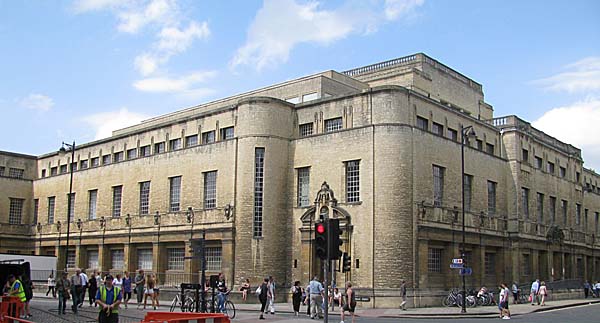The facade of the
building is decorated with 21 cartouches
that contain the coats of arms of a
number of people associated with the
university and/or the library.
According to the "headington.org.uk"
website, these are, in order starting
from the left hand end of the facade on
The Broad and carrying on around the
corner on Parks Road:
Sir Giles Gilbert Scott, the building's
architect
Sir Edmund Craster, a British librarian,
who served as Bodley's Librarian from 1931
to 1945.
Viscount Grey, Chancellor of the
University of Oxford from 1928 to 1933
Cecil Rhodes: In his
last will and testament he provided for
the establishment of the famous Rhodes
Scholarship, the world's first
international study program. The
scholarship enabled students from
territories under British rule or
formerly under British rule and from
Germany to study at Rhodes's alma mater,
the University of Oxford.
John Radcliffe: He
graduated from the University of
Oxford, where he was an exhibitioner
Fellow of Lincoln College. He
was a physician, academic and
politician. A number of landmark
buildings in Oxford are named after
him including: the Radcliffe Camera,
the Radcliffe Observatory, and the
John Radcliffe Hospital. On his
death his property was bequeathed to
various charitable causes, including
University College, Oxford.
Duke Humfrey: The
younger son of Henry IV. He was a
connoisseur of literature and
commissioned translations of classical
works from Greek into Latin. When he
died in 1447, he donated his
collection of 281 manuscripts to the
University of Oxford.
Thomas de Cobham: According to the
Bodleian Library's website,
"The first library for Oxford
University – as distinct from the
colleges – was housed in a room
above the Old Congregation House,
begun c.1320 on a site to the north
of the chancel of the University
Church of St Mary the Virgin. The
building stood at the heart of
Oxford’s ‘academic quarter’, close
to the schools in which lectures
were given. The library was built
with funds supplied by Thomas de
Cobham, Bishop of Worcester, but was
still unfinished when he died in
1327."

William Laud, went
in 1589 to St John's College, Oxford.
In 1593 he became a fellow of the
college. Laud was a major
collector of manuscripts.

William Herbert
the 3rd Earl of Pembroke 1580 – 1630,
Chancellor of the University of Oxford
and founder of Pembroke College. The
First Folio of William Shakespeare's
plays was dedicated to him, together
with his brother, Philip Herbert.

Sir Kenelm
Digby: He went to Gloucester Hall,
Oxford in 1618, where he was
taught by Thomas Allen. Allen
bequeathed to Digby his library, and
he in turn, donated it to the Bodleian.
Richard Rawlinson,
(1690 – 1755) was an English clergyman
and antiquarian collector of books and
manuscripts, which he bequeathed to
the Bodleian Library.
Francis Douce,
(1757 - 1834), he left his printed
books, illuminated manuscripts, coins
&c., to the Bodleian Library
The University of
Oxford

John Selden, (1584
- 1654), assembled a famous library,
that in 1659 became part of the
Bodleian Library's collections
Thomas Tanner: His valuable
collection of books and manuscripts is
in the Bodleian Library.
Richard Gough,
(1735 - 1809), his books and
manuscripts relating to Anglo-Saxon
and northern literature, all his
collections in the department of
British topography, and a large number
of his drawings and engravings of
other archaeological remains, were
bequeathed to the University
of
Oxford. Notable in the
bequest is the so-called Gough Map, an
outstanding medieval map of Britain,
which is now known by Gough’s name.
Lord Sunderlin:
The Shakespearian scholar Edmund
Malone (1741 - 1812), bequeathed his
library to his brother, Lord
Sunderlin, who presented it to the
Bodleian in 1815.

Thomas, 2nd Earl
Brassey, (1863 - 1919), educated at
Balliol College, Oxford, he became a
British peer, who was for many years
editor or joint editor of Brassey's
Naval Annual.








